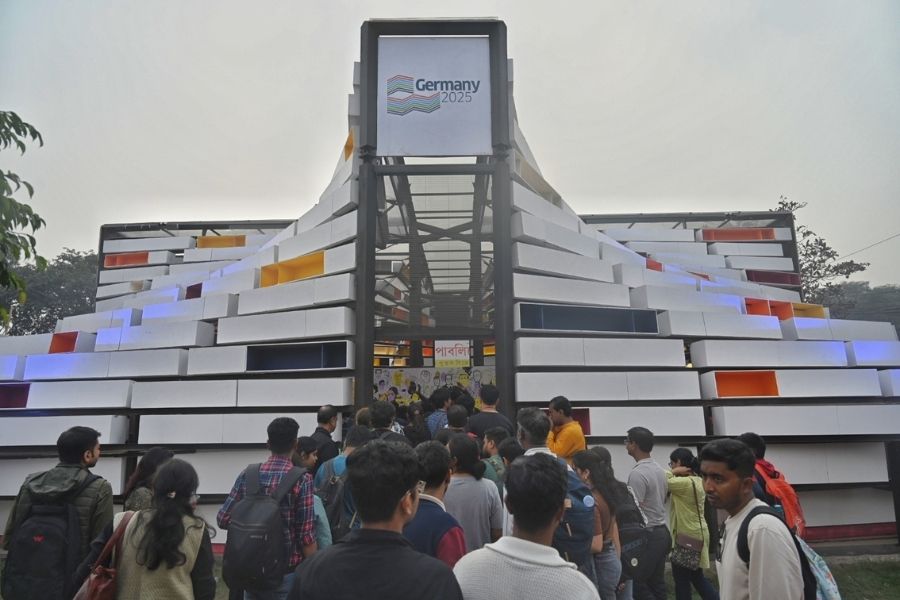 Sunday, 02 February 2025
Sunday, 02 February 2025
 Sunday, 02 February 2025
Sunday, 02 February 2025
The 46th session of Unesco's World Heritage Committee, that is being held in New Delhi from July 21 to 31, 2024, has resulted in the inscription of several new sites to the World Heritage list. These additions span various countries and showcase a range of cultural and natural heritage. Here's a detailed look at the newly inscribed sites:
Moidams – the mound-burial system of the Ahom dynasty (Assam, India)
The Moidams, located in the foothills of the Patkai Ranges in eastern Assam, represent a unique royal burial tradition of the Tai-Ahom people. These sacred mound burials, constructed from the 13th to the 19th century CE, reflect the Tai-Ahom's distinct funerary practices and beliefs in the divinity of their monarchs.
The site includes the city of Charaideo, established as the first Tai-Ahom capital and royal necropolis. Over time, the construction methods evolved from wood to stone and burnt bricks. The Archaeological Survey of India and the Assam State Department of Archaeology have worked to preserve and restore the site, which now enjoys protection under both central and state regulations.
Tell Umm Amer (Palestine)
This Palestinian site has been simultaneously added to the World Heritage List and the List of World Heritage in Danger. Located on coastal dunes in Nuseirat Municipality, the ruins of Saint Hilarion Monastery represent one of the earliest monastic sites in the Middle East, dating back to the 4th century.
Founded by Saint Hilarion, the monastery evolved from solitary hermits to a coenobitic community. Its strategic position at the crossroads of major trade routes facilitated religious, cultural, and economic interchange. The site exemplifies the flourishing of monastic desert centers during the Byzantine period.
Umm Al-Jimāl (Jordan)
Umm Al-Jimāl is a rural settlement in northern Jordan that developed organically from the 5th to the 8th century CE on the site of an earlier Roman settlement. The property preserves basaltic structures from the Byzantine and Early Islamic periods, representing the local architecture style of the Hauran region.
The settlement was part of a broader agricultural landscape that included a complex water catchment system. Umm Al-Jimāl's history can be traced back to the 1st century CE when it was part of the Nabataean Kingdom. A rich epigraphic corpus in various languages provides insights into its history and the religious evolution of its inhabitants.
Badain Jaran Desert - Towers of sand and lakes (China)
Located in the Alashan Plateau in northwestern China, the Badain Jaran Desert is the country's third-largest desert and second-largest drifting desert. The site is characterized by its high density of mega-dunes intersected with inter-dunal lakes.
Notable features include the world's tallest stabilized sand mega-dune, the highest concentration of inter-dunal lakes, and extensive areas of "singing sands." The varied landscape contributes to high habitat diversity and biodiversity.
Vjetrenica Cave (Bosnia and Herzegovina)
Vjetrenica, meaning "wind cave" or "blowhole," is the largest cave in Bosnia and Herzegovina and is renowned for its exceptional biodiversity. Located in the Dinaric Alps mountain range, it is a prime example of karst topography.
The cave is one of the world's most important biodiversity hotspots for cave-dwelling fauna, particularly subterranean aquatic species. It hosts several globally threatened vertebrate species and the world's only subterranean tubeworm. Many species found in Vjetrenica are considered living fossils, with their closest relatives long extinct.
Te Henua Enata - The Marquesas Islands (France)
This French Polynesian archipelago in the Pacific combines exceptional cultural and natural values. The islands feature dramatic landscapes with sharp volcanic ridges, phonolitic needles, and steep sea cliffs, topped by unique cloud forests.
The archipelago boasts one of the most diverse seabird assemblages in the South Pacific and is a major center of marine endemism. The property also bears witness to the adaptability of human civilization that arrived around 1000 CE, developing a unique culture closely linked to the natural environment.
The Flow Country (United Kingdom)
The Flow Country, located in Scotland, represents one of the largest areas of blanket bog in the world. This rare form of peatland ecosystem supports highly specialized species and makes a significant contribution to biodiversity.
Peatlands, despite covering only 3% of the global landmass, store around 600Gt of carbon, more than all the world's forests combined. The Flow Country's inscription recognizes the importance of peatlands in global carbon storage and climate regulation.
Lençóis Maranhenses national park (Brazil)
This national park in Maranhão state, northeastern Brazil, encompasses 155,000 hectares of coastline and interior sand dunes. During the rainy season, the valleys between dunes fill with freshwater lagoons, creating a unique landscape.
The park receives about 1,200 mm of rain annually, distinguishing it from true deserts. It hosts a variety of ecosystems including dunes, restingas, and mangroves, supporting diverse flora and fauna, including several endangered species.
Royal Court of Tiébélé (Burkina Faso)
The Royal Court of Tiébélé represents a form of vernacular architecture and traditions dating back to the 16th century. It comprises a large compound of painted houses, traditionally decorated by women. The buildings are constructed using earth, wood, and straw, showcasing unique architectural and artistic traditions of the region.
Melka Kunture and Balchit: Archaeological and palaeontological sites (Ethiopia)
Melka Kunture is a cluster of prehistoric sites in the upper Awash valley, 50 km south of Addis Ababa. The site provides valuable insights into human evolution and tool-making, with archaeological levels dating back to nearly 2 million years ago.
The site includes various archaeological levels, from Oldowan to Late Stone Age, and has yielded important hominid remains. The nearby Balchit area features obsidian outcrops that were an important source of raw material for tool-making throughout prehistory.
The emergence of modern human behaviour: The pleistocene occupation sites of South Africa
This serial inscription includes three South African Middle Stone Age sites: Sibhudu Cave in KwaZulu-Natal, Diepkloof Rock Shelter near Elands Bay, and the Pinnacle Point Site Complex in Mossel Bay, Western Cape.
These sites provide exceptional evidence for the emergence of modern human behavior during the Pleistocene era. They offer insights into human adaptation, ingenuity, and resilience in the face of environmental changes, and have been meticulously preserved through international research efforts.
Human rights, liberation and reconciliation: Nelson Mandela legacy sites (South Africa)
The serial property represents the legacy of the South African struggle for human rights, liberation and reconciliation. It consists of fourteen component parts located around the country, all related to South Africa’s political history in the 20th century. The parts include the Union Buildings (Pretoria), now the official seat of government; the Sharpeville Sites, commemorating the massacre of 69 people protesting the unjust Pass Laws; and The Great Place at Mqhekezweni, a site symbolic of traditional leadership where Nelson Mandela lived as a young man. These places reflect key events linked to the long struggle against the apartheid state; Mandela’s influence in promoting understanding and forgiveness; and belief systems based on philosophies of non-racialism, Pan-Africanism and ubuntu, a concept that implies humanity is not solely embedded in an individual.
These new inscriptions reflect Unesco's ongoing efforts to recognise and protect diverse cultural and natural heritage sites around the world. In 2023, Santiniketan, the cultural and educational hub established by Rabindranath Tagore, was added to the UNESCO World Heritage List for its significance in promoting universal humanism through art, literature, and learning. Similarly, in 2021, Durga Pujo, the vibrant annual Hindu festival celebrated predominantly in West Bengal, was recognised by UNESCO for its rich cultural traditions, artistic installations, and communal harmony, showcasing the unique rituals and creative expressions associated with the worship of the goddess Durga.







